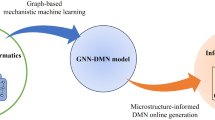Abstract
The properties and functionalities of inorganic glasses can be tuned by adjusting their chemical composition and, in turn, their atomic-scale structure. However, accurate prediction of glass properties from composition has traditionally been impossible. Recent progress in temperature-dependent constraint theory paves the way for the design of new multicomponent glasses with tailored properties. Atoms in network glasses are constrained by their chemical bonds and bond angles, and the strength of these constraints depends on the local topology and the chemical nature of the elements. By counting the number of constraints around both network-forming and network-modifying atoms as a function of both composition and temperature, it is possible to make quantitative connections among composition, structure, and certain macroscopic properties. Here, we review recent developments in glass-structure determination and modeling. We then demonstrate how the structural information is used as input for topological predictions of glass properties such as viscosity and hardness. These predictions enable the design of novel industrial glasses with desired properties and manufacturing attributes.



Similar content being viewed by others
References
G.N. Greaves, S. Sen, Adv. Phys. 56, 1 (2007).
J.C. Phillips, J. Non Cryst. Solids 34, 153 (1979).
J.C. Phillips, M.F. Thorpe, Solid State Commun. 53, 699 (1985).
P.K. Gupta, J.C. Mauro, J. Chem. Phys. 130, 094503 (2009).
J.C. Mauro, P.K. Gupta, R.J. Loucks, J. Chem. Phys. 130, 234503 (2009).
M.M. Smedskjaer, J.C. Mauro, Y.Z. Yue, Phys. Rev. Lett. 105, 115503 (2010).
M.M. Smedskjaer, M. Bauchy, Appl. Phys. Lett. 107, 141901 (2015).
I. Pignatelli, A. Kumar, M. Bauchy, G. Sant, Langmuir 32, 4434 (2016).
W.H. Zachariasen, J. Am. Chem. Soc. 54, 3841 (1932).
A.H. Silver, P.J. Bray, J. Chem. Phys. 29, 984 (1958).
S. Ispas, T. Charpentier, F. Mauri, D.R. Neuville, Solid State Sci. 12, 183 (2010).
M.M. Smedskjaer, Front. Mater. 1, 23 (2014).
M.M. Smedskjaer, J.C. Mauro, R.E. Youngman, C.L. Hogue, M. Potuzak, Y.Z. Yue, J. Phys. Chem. B 115, 12930 (2011).
M. Bauchy, M. Micoulaut, J. Non Cryst. Solids 357, 2530 (2011).
K.H. Sun, J. Am. Ceram. Soc. 30, 277 (1947).
C. Hermansen, J.C. Mauro, Y.Z. Yue, J. Chem. Phys. 140, 154501 (2014).
C. Hermansen, B. Rodrigues, L. Wondraczek, Y.Z. Yue, J. Chem. Phys. 141, 244502 (2014).
J.C. Mauro, Y.Z. Yue, A.J. Ellison, P.K. Gupta, D.C. Allan, Proc. Natl. Acad. Sci. U.S.A. 106, 19780 (2009).
Q.J. Zheng, J.C. Mauro, A.J. Ellison, M. Potuzak, Y.Z. Yue, Phys. Rev. B Condens. Matter 83, 212202 (2011).
Y.Z. Yue, J. Non Cryst. Solids 355, 737 (2009).
G. Adam, J.H. Gibbs, J. Chem. Phys. 43, 139 (1965)
G.G. Naumis, Phys. Rev. E 71, 026114 (2005).
M.M. Smedskjaer, J.C. Mauro, S. Sen, Y.Z. Yue, Chem. Mater. 22, 5358 (2010).
Q. Jiang, H. Zeng, Z. Liu, J. Ren, G. Chen, Z. Wang, L. Sun, D. Zhao, J. Chem. Phys. 139, 124502 (2013).
C. Hermansen, R.E. Youngman, J. Wang, Y.Z. Yue, J. Chem. Phys. 142, 184503 (2015).
H. Zeng, Q. Jiang, Z. Liu, X. Li, J. Ren, G. Chen, F. Liu, S. Peng, J. Phys. Chem. B 118, 5177 (2014).
C. Hermansen, X.J. Guo, R.E. Youngman, J.C. Mauro, M.M. Smedskjaer, Y.Z. Yue, J. Chem. Phys. 143, 064510 (2015).
M. Yamane, J.D. Mackenzie, J. Non Cryst. Solids 15, 153 (1974).
J.C. Mauro, A. Tandia, K.D. Vargheese, Y.Z. Mauro, M.M. Smedskjaer, Chem. Mater. 28, 4267 (2016).
Acknowledgments
We thank J.C. Mauro and Y.Z. Yue for the collaboration on temperature-dependent constraints over the years. M.M.S. acknowledges support of the Danish Council for Independent Research (Sapere Aude Starting Grant), Lundbeck Foundation, and VILLUM Fonden.
Author information
Authors and Affiliations
Corresponding author
Rights and permissions
About this article
Cite this article
Smedskjaer, M.M., Hermansen, C. & Youngman, R.E. Topological engineering of glasses using temperature-dependent constraints. MRS Bulletin 42, 29–33 (2017). https://doi.org/10.1557/mrs.2016.299
Published:
Issue Date:
DOI: https://doi.org/10.1557/mrs.2016.299




